Art Movements and Their Propaganda: A Historical Analysis
VerifiedAdded on 2022/11/24
|11
|3120
|226
AI Summary
This article delves into the use of propaganda in various art movements such as Renaissance, Baroque, Age of Enlightenment, and Modernism. It explores how artists used their work to convey subtle messages and comment on societal issues. The article also discusses the influence of Greek and Ro...
Read More
Contribute Materials
Your contribution can guide someone’s learning journey. Share your
documents today.
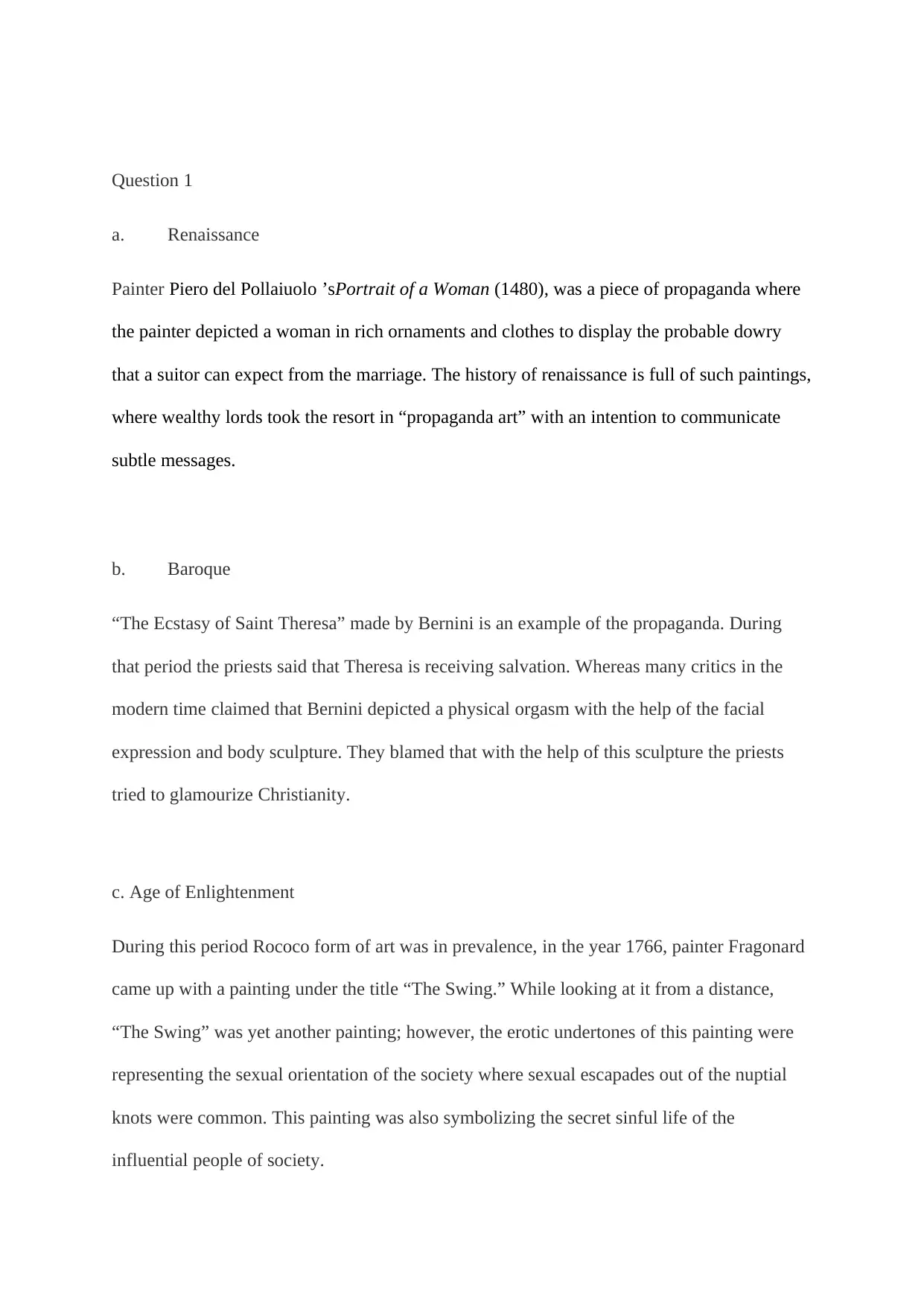
Question 1
a. Renaissance
Painter Piero del Pollaiuolo ’sPortrait of a Woman (1480), was a piece of propaganda where
the painter depicted a woman in rich ornaments and clothes to display the probable dowry
that a suitor can expect from the marriage. The history of renaissance is full of such paintings,
where wealthy lords took the resort in “propaganda art” with an intention to communicate
subtle messages.
b. Baroque
“The Ecstasy of Saint Theresa” made by Bernini is an example of the propaganda. During
that period the priests said that Theresa is receiving salvation. Whereas many critics in the
modern time claimed that Bernini depicted a physical orgasm with the help of the facial
expression and body sculpture. They blamed that with the help of this sculpture the priests
tried to glamourize Christianity.
c. Age of Enlightenment
During this period Rococo form of art was in prevalence, in the year 1766, painter Fragonard
came up with a painting under the title “The Swing.” While looking at it from a distance,
“The Swing” was yet another painting; however, the erotic undertones of this painting were
representing the sexual orientation of the society where sexual escapades out of the nuptial
knots were common. This painting was also symbolizing the secret sinful life of the
influential people of society.
a. Renaissance
Painter Piero del Pollaiuolo ’sPortrait of a Woman (1480), was a piece of propaganda where
the painter depicted a woman in rich ornaments and clothes to display the probable dowry
that a suitor can expect from the marriage. The history of renaissance is full of such paintings,
where wealthy lords took the resort in “propaganda art” with an intention to communicate
subtle messages.
b. Baroque
“The Ecstasy of Saint Theresa” made by Bernini is an example of the propaganda. During
that period the priests said that Theresa is receiving salvation. Whereas many critics in the
modern time claimed that Bernini depicted a physical orgasm with the help of the facial
expression and body sculpture. They blamed that with the help of this sculpture the priests
tried to glamourize Christianity.
c. Age of Enlightenment
During this period Rococo form of art was in prevalence, in the year 1766, painter Fragonard
came up with a painting under the title “The Swing.” While looking at it from a distance,
“The Swing” was yet another painting; however, the erotic undertones of this painting were
representing the sexual orientation of the society where sexual escapades out of the nuptial
knots were common. This painting was also symbolizing the secret sinful life of the
influential people of society.
Secure Best Marks with AI Grader
Need help grading? Try our AI Grader for instant feedback on your assignments.
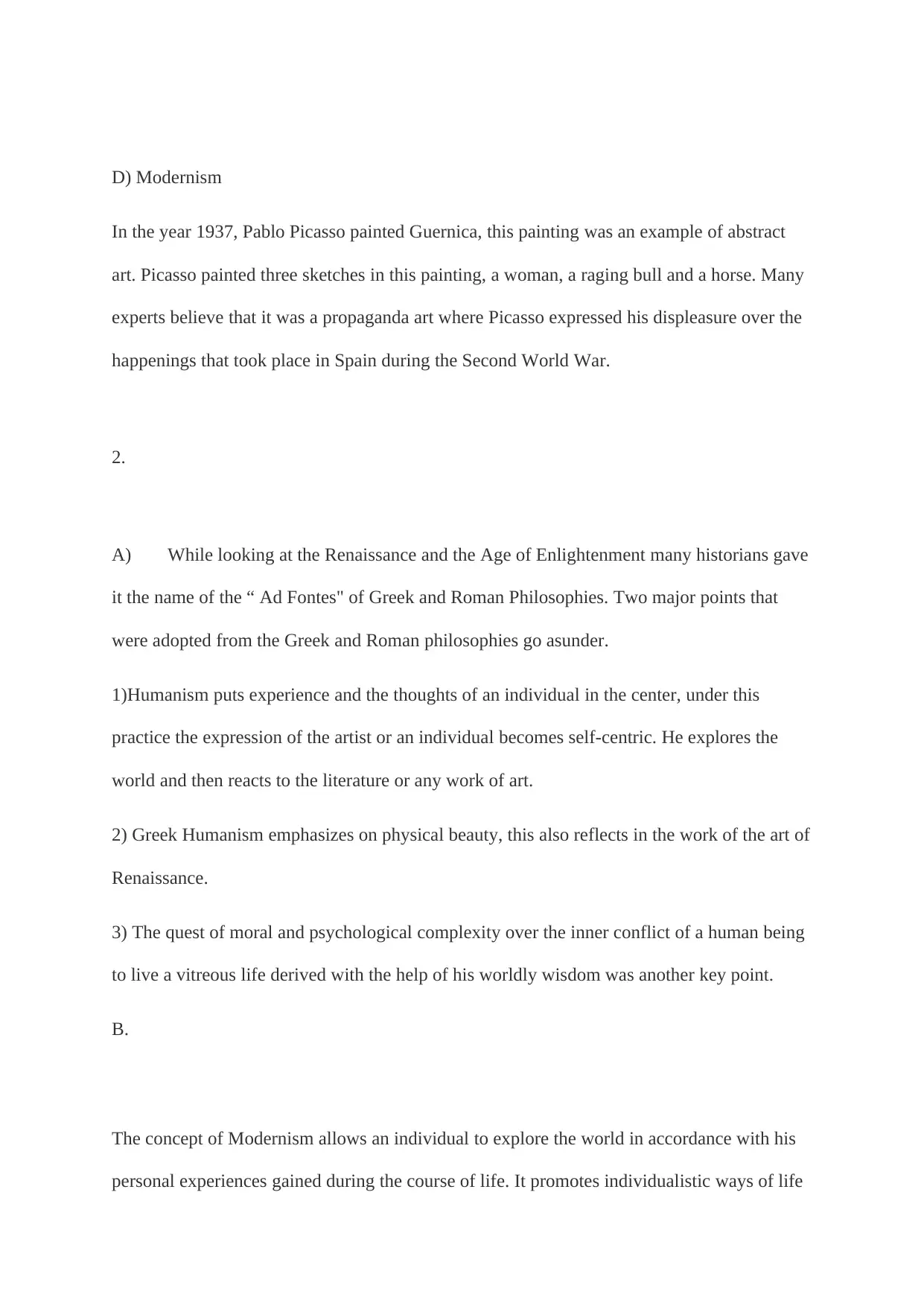
D) Modernism
In the year 1937, Pablo Picasso painted Guernica, this painting was an example of abstract
art. Picasso painted three sketches in this painting, a woman, a raging bull and a horse. Many
experts believe that it was a propaganda art where Picasso expressed his displeasure over the
happenings that took place in Spain during the Second World War.
2.
A) While looking at the Renaissance and the Age of Enlightenment many historians gave
it the name of the “ Ad Fontes" of Greek and Roman Philosophies. Two major points that
were adopted from the Greek and Roman philosophies go asunder.
1)Humanism puts experience and the thoughts of an individual in the center, under this
practice the expression of the artist or an individual becomes self-centric. He explores the
world and then reacts to the literature or any work of art.
2) Greek Humanism emphasizes on physical beauty, this also reflects in the work of the art of
Renaissance.
3) The quest of moral and psychological complexity over the inner conflict of a human being
to live a vitreous life derived with the help of his worldly wisdom was another key point.
B.
The concept of Modernism allows an individual to explore the world in accordance with his
personal experiences gained during the course of life. It promotes individualistic ways of life
In the year 1937, Pablo Picasso painted Guernica, this painting was an example of abstract
art. Picasso painted three sketches in this painting, a woman, a raging bull and a horse. Many
experts believe that it was a propaganda art where Picasso expressed his displeasure over the
happenings that took place in Spain during the Second World War.
2.
A) While looking at the Renaissance and the Age of Enlightenment many historians gave
it the name of the “ Ad Fontes" of Greek and Roman Philosophies. Two major points that
were adopted from the Greek and Roman philosophies go asunder.
1)Humanism puts experience and the thoughts of an individual in the center, under this
practice the expression of the artist or an individual becomes self-centric. He explores the
world and then reacts to the literature or any work of art.
2) Greek Humanism emphasizes on physical beauty, this also reflects in the work of the art of
Renaissance.
3) The quest of moral and psychological complexity over the inner conflict of a human being
to live a vitreous life derived with the help of his worldly wisdom was another key point.
B.
The concept of Modernism allows an individual to explore the world in accordance with his
personal experiences gained during the course of life. It promotes individualistic ways of life
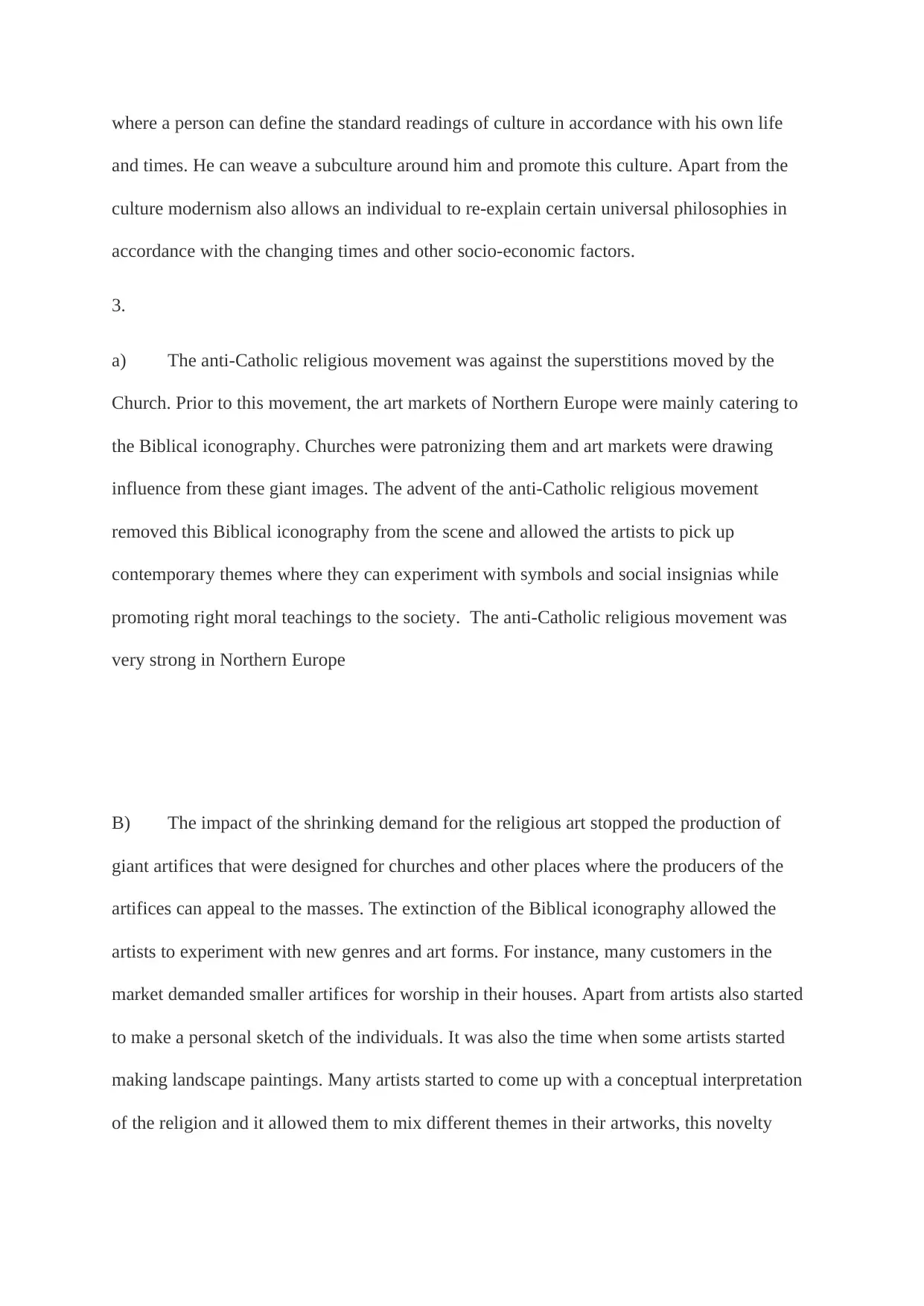
where a person can define the standard readings of culture in accordance with his own life
and times. He can weave a subculture around him and promote this culture. Apart from the
culture modernism also allows an individual to re-explain certain universal philosophies in
accordance with the changing times and other socio-economic factors.
3.
a) The anti-Catholic religious movement was against the superstitions moved by the
Church. Prior to this movement, the art markets of Northern Europe were mainly catering to
the Biblical iconography. Churches were patronizing them and art markets were drawing
influence from these giant images. The advent of the anti-Catholic religious movement
removed this Biblical iconography from the scene and allowed the artists to pick up
contemporary themes where they can experiment with symbols and social insignias while
promoting right moral teachings to the society. The anti-Catholic religious movement was
very strong in Northern Europe
B) The impact of the shrinking demand for the religious art stopped the production of
giant artifices that were designed for churches and other places where the producers of the
artifices can appeal to the masses. The extinction of the Biblical iconography allowed the
artists to experiment with new genres and art forms. For instance, many customers in the
market demanded smaller artifices for worship in their houses. Apart from artists also started
to make a personal sketch of the individuals. It was also the time when some artists started
making landscape paintings. Many artists started to come up with a conceptual interpretation
of the religion and it allowed them to mix different themes in their artworks, this novelty
and times. He can weave a subculture around him and promote this culture. Apart from the
culture modernism also allows an individual to re-explain certain universal philosophies in
accordance with the changing times and other socio-economic factors.
3.
a) The anti-Catholic religious movement was against the superstitions moved by the
Church. Prior to this movement, the art markets of Northern Europe were mainly catering to
the Biblical iconography. Churches were patronizing them and art markets were drawing
influence from these giant images. The advent of the anti-Catholic religious movement
removed this Biblical iconography from the scene and allowed the artists to pick up
contemporary themes where they can experiment with symbols and social insignias while
promoting right moral teachings to the society. The anti-Catholic religious movement was
very strong in Northern Europe
B) The impact of the shrinking demand for the religious art stopped the production of
giant artifices that were designed for churches and other places where the producers of the
artifices can appeal to the masses. The extinction of the Biblical iconography allowed the
artists to experiment with new genres and art forms. For instance, many customers in the
market demanded smaller artifices for worship in their houses. Apart from artists also started
to make a personal sketch of the individuals. It was also the time when some artists started
making landscape paintings. Many artists started to come up with a conceptual interpretation
of the religion and it allowed them to mix different themes in their artworks, this novelty
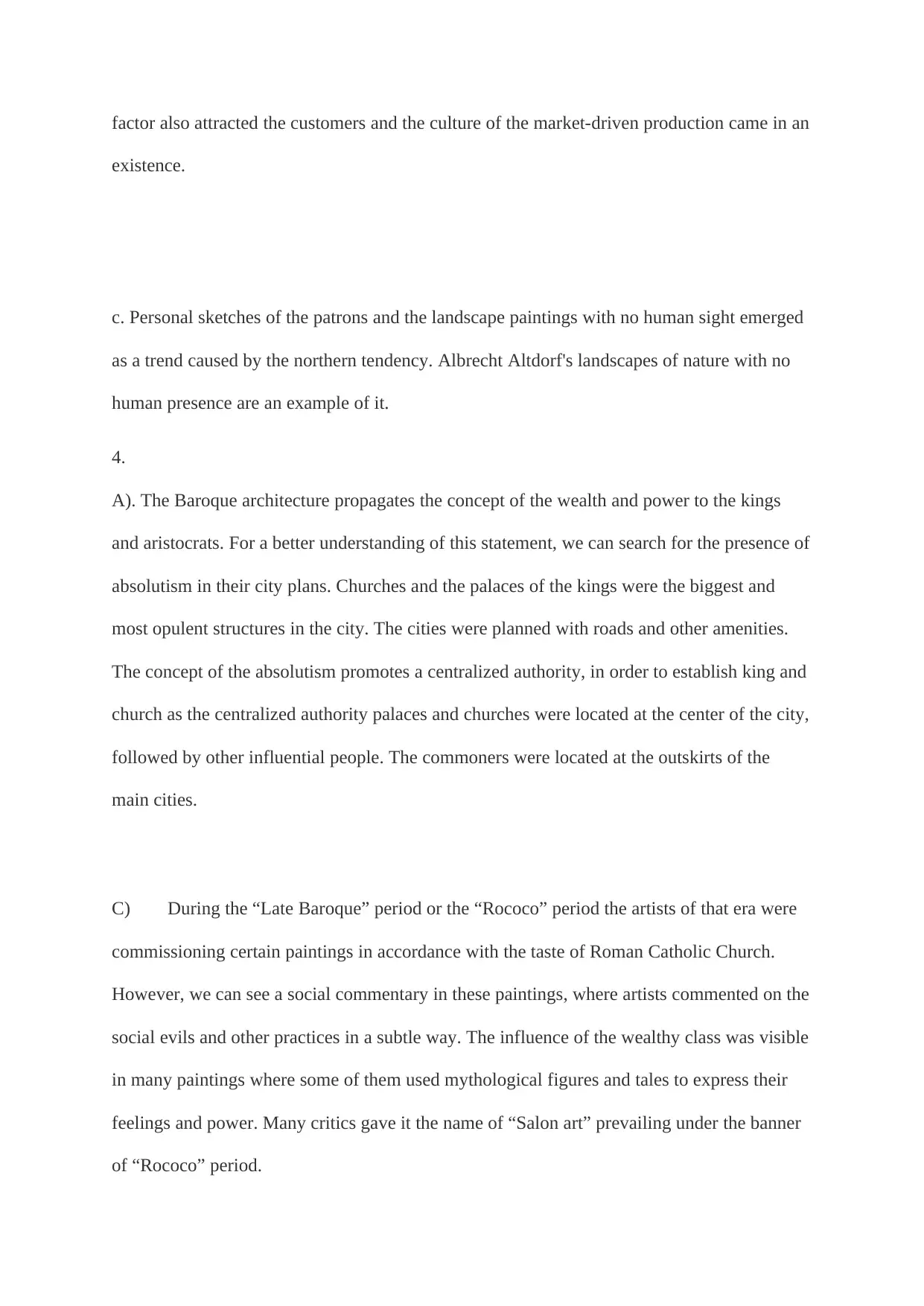
factor also attracted the customers and the culture of the market-driven production came in an
existence.
c. Personal sketches of the patrons and the landscape paintings with no human sight emerged
as a trend caused by the northern tendency. Albrecht Altdorf's landscapes of nature with no
human presence are an example of it.
4.
A). The Baroque architecture propagates the concept of the wealth and power to the kings
and aristocrats. For a better understanding of this statement, we can search for the presence of
absolutism in their city plans. Churches and the palaces of the kings were the biggest and
most opulent structures in the city. The cities were planned with roads and other amenities.
The concept of the absolutism promotes a centralized authority, in order to establish king and
church as the centralized authority palaces and churches were located at the center of the city,
followed by other influential people. The commoners were located at the outskirts of the
main cities.
C) During the “Late Baroque” period or the “Rococo” period the artists of that era were
commissioning certain paintings in accordance with the taste of Roman Catholic Church.
However, we can see a social commentary in these paintings, where artists commented on the
social evils and other practices in a subtle way. The influence of the wealthy class was visible
in many paintings where some of them used mythological figures and tales to express their
feelings and power. Many critics gave it the name of “Salon art” prevailing under the banner
of “Rococo” period.
existence.
c. Personal sketches of the patrons and the landscape paintings with no human sight emerged
as a trend caused by the northern tendency. Albrecht Altdorf's landscapes of nature with no
human presence are an example of it.
4.
A). The Baroque architecture propagates the concept of the wealth and power to the kings
and aristocrats. For a better understanding of this statement, we can search for the presence of
absolutism in their city plans. Churches and the palaces of the kings were the biggest and
most opulent structures in the city. The cities were planned with roads and other amenities.
The concept of the absolutism promotes a centralized authority, in order to establish king and
church as the centralized authority palaces and churches were located at the center of the city,
followed by other influential people. The commoners were located at the outskirts of the
main cities.
C) During the “Late Baroque” period or the “Rococo” period the artists of that era were
commissioning certain paintings in accordance with the taste of Roman Catholic Church.
However, we can see a social commentary in these paintings, where artists commented on the
social evils and other practices in a subtle way. The influence of the wealthy class was visible
in many paintings where some of them used mythological figures and tales to express their
feelings and power. Many critics gave it the name of “Salon art” prevailing under the banner
of “Rococo” period.
Secure Best Marks with AI Grader
Need help grading? Try our AI Grader for instant feedback on your assignments.
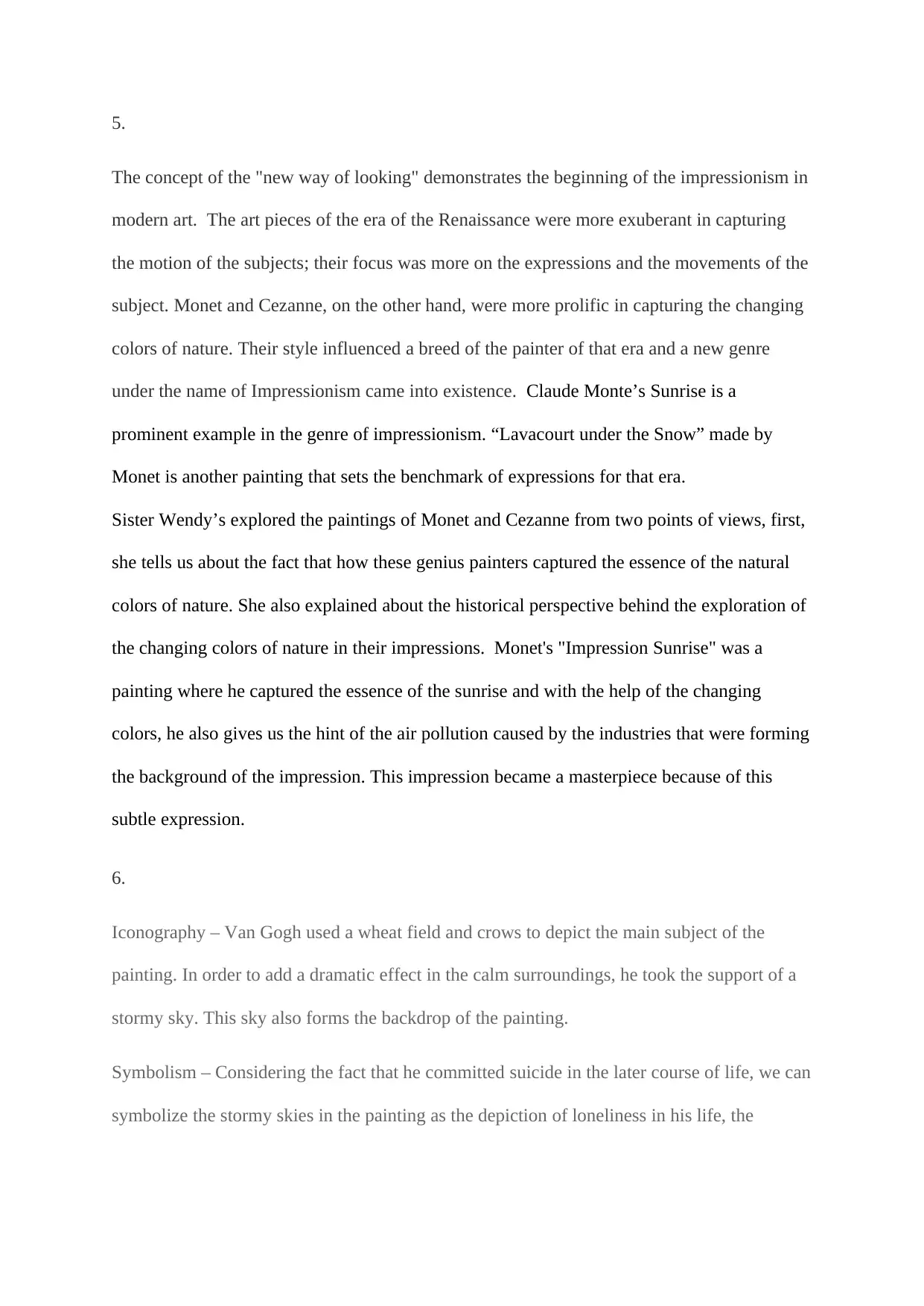
5.
The concept of the "new way of looking" demonstrates the beginning of the impressionism in
modern art. The art pieces of the era of the Renaissance were more exuberant in capturing
the motion of the subjects; their focus was more on the expressions and the movements of the
subject. Monet and Cezanne, on the other hand, were more prolific in capturing the changing
colors of nature. Their style influenced a breed of the painter of that era and a new genre
under the name of Impressionism came into existence. Claude Monte’s Sunrise is a
prominent example in the genre of impressionism. “Lavacourt under the Snow” made by
Monet is another painting that sets the benchmark of expressions for that era.
Sister Wendy’s explored the paintings of Monet and Cezanne from two points of views, first,
she tells us about the fact that how these genius painters captured the essence of the natural
colors of nature. She also explained about the historical perspective behind the exploration of
the changing colors of nature in their impressions. Monet's "Impression Sunrise" was a
painting where he captured the essence of the sunrise and with the help of the changing
colors, he also gives us the hint of the air pollution caused by the industries that were forming
the background of the impression. This impression became a masterpiece because of this
subtle expression.
6.
Iconography – Van Gogh used a wheat field and crows to depict the main subject of the
painting. In order to add a dramatic effect in the calm surroundings, he took the support of a
stormy sky. This sky also forms the backdrop of the painting.
Symbolism – Considering the fact that he committed suicide in the later course of life, we can
symbolize the stormy skies in the painting as the depiction of loneliness in his life, the
The concept of the "new way of looking" demonstrates the beginning of the impressionism in
modern art. The art pieces of the era of the Renaissance were more exuberant in capturing
the motion of the subjects; their focus was more on the expressions and the movements of the
subject. Monet and Cezanne, on the other hand, were more prolific in capturing the changing
colors of nature. Their style influenced a breed of the painter of that era and a new genre
under the name of Impressionism came into existence. Claude Monte’s Sunrise is a
prominent example in the genre of impressionism. “Lavacourt under the Snow” made by
Monet is another painting that sets the benchmark of expressions for that era.
Sister Wendy’s explored the paintings of Monet and Cezanne from two points of views, first,
she tells us about the fact that how these genius painters captured the essence of the natural
colors of nature. She also explained about the historical perspective behind the exploration of
the changing colors of nature in their impressions. Monet's "Impression Sunrise" was a
painting where he captured the essence of the sunrise and with the help of the changing
colors, he also gives us the hint of the air pollution caused by the industries that were forming
the background of the impression. This impression became a masterpiece because of this
subtle expression.
6.
Iconography – Van Gogh used a wheat field and crows to depict the main subject of the
painting. In order to add a dramatic effect in the calm surroundings, he took the support of a
stormy sky. This sky also forms the backdrop of the painting.
Symbolism – Considering the fact that he committed suicide in the later course of life, we can
symbolize the stormy skies in the painting as the depiction of loneliness in his life, the
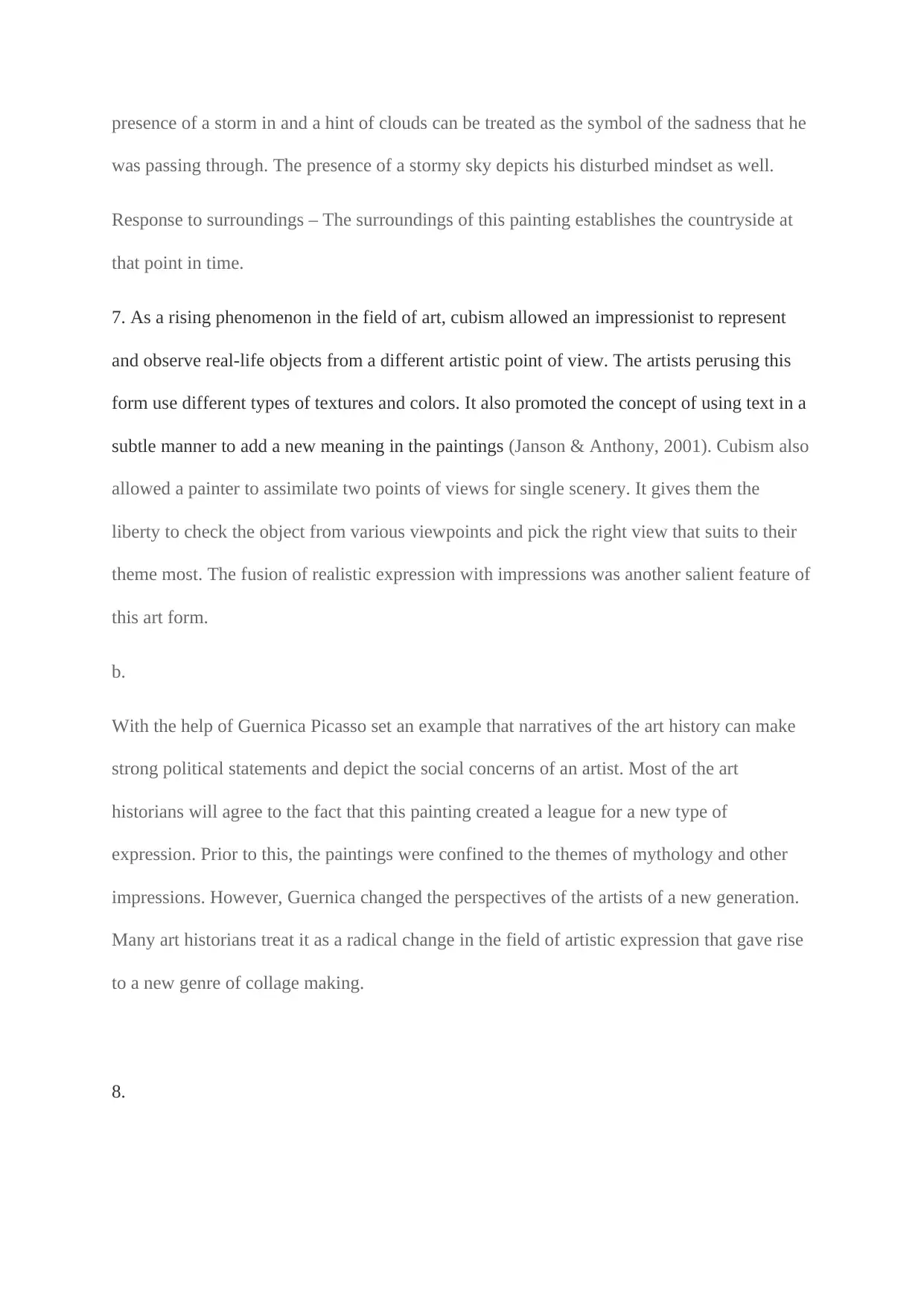
presence of a storm in and a hint of clouds can be treated as the symbol of the sadness that he
was passing through. The presence of a stormy sky depicts his disturbed mindset as well.
Response to surroundings – The surroundings of this painting establishes the countryside at
that point in time.
7. As a rising phenomenon in the field of art, cubism allowed an impressionist to represent
and observe real-life objects from a different artistic point of view. The artists perusing this
form use different types of textures and colors. It also promoted the concept of using text in a
subtle manner to add a new meaning in the paintings (Janson & Anthony, 2001). Cubism also
allowed a painter to assimilate two points of views for single scenery. It gives them the
liberty to check the object from various viewpoints and pick the right view that suits to their
theme most. The fusion of realistic expression with impressions was another salient feature of
this art form.
b.
With the help of Guernica Picasso set an example that narratives of the art history can make
strong political statements and depict the social concerns of an artist. Most of the art
historians will agree to the fact that this painting created a league for a new type of
expression. Prior to this, the paintings were confined to the themes of mythology and other
impressions. However, Guernica changed the perspectives of the artists of a new generation.
Many art historians treat it as a radical change in the field of artistic expression that gave rise
to a new genre of collage making.
8.
was passing through. The presence of a stormy sky depicts his disturbed mindset as well.
Response to surroundings – The surroundings of this painting establishes the countryside at
that point in time.
7. As a rising phenomenon in the field of art, cubism allowed an impressionist to represent
and observe real-life objects from a different artistic point of view. The artists perusing this
form use different types of textures and colors. It also promoted the concept of using text in a
subtle manner to add a new meaning in the paintings (Janson & Anthony, 2001). Cubism also
allowed a painter to assimilate two points of views for single scenery. It gives them the
liberty to check the object from various viewpoints and pick the right view that suits to their
theme most. The fusion of realistic expression with impressions was another salient feature of
this art form.
b.
With the help of Guernica Picasso set an example that narratives of the art history can make
strong political statements and depict the social concerns of an artist. Most of the art
historians will agree to the fact that this painting created a league for a new type of
expression. Prior to this, the paintings were confined to the themes of mythology and other
impressions. However, Guernica changed the perspectives of the artists of a new generation.
Many art historians treat it as a radical change in the field of artistic expression that gave rise
to a new genre of collage making.
8.
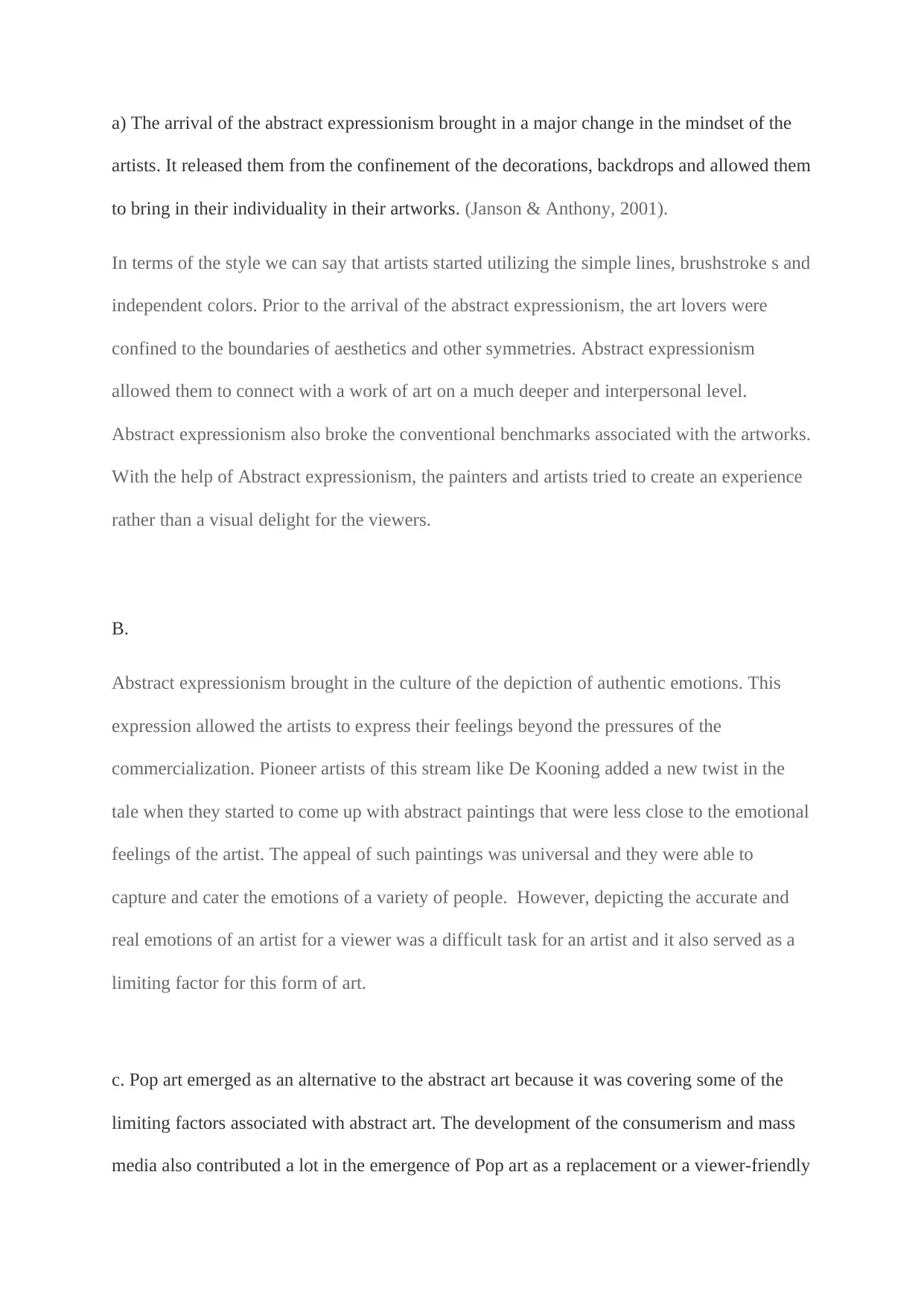
a) The arrival of the abstract expressionism brought in a major change in the mindset of the
artists. It released them from the confinement of the decorations, backdrops and allowed them
to bring in their individuality in their artworks. (Janson & Anthony, 2001).
In terms of the style we can say that artists started utilizing the simple lines, brushstroke s and
independent colors. Prior to the arrival of the abstract expressionism, the art lovers were
confined to the boundaries of aesthetics and other symmetries. Abstract expressionism
allowed them to connect with a work of art on a much deeper and interpersonal level.
Abstract expressionism also broke the conventional benchmarks associated with the artworks.
With the help of Abstract expressionism, the painters and artists tried to create an experience
rather than a visual delight for the viewers.
B.
Abstract expressionism brought in the culture of the depiction of authentic emotions. This
expression allowed the artists to express their feelings beyond the pressures of the
commercialization. Pioneer artists of this stream like De Kooning added a new twist in the
tale when they started to come up with abstract paintings that were less close to the emotional
feelings of the artist. The appeal of such paintings was universal and they were able to
capture and cater the emotions of a variety of people. However, depicting the accurate and
real emotions of an artist for a viewer was a difficult task for an artist and it also served as a
limiting factor for this form of art.
c. Pop art emerged as an alternative to the abstract art because it was covering some of the
limiting factors associated with abstract art. The development of the consumerism and mass
media also contributed a lot in the emergence of Pop art as a replacement or a viewer-friendly
artists. It released them from the confinement of the decorations, backdrops and allowed them
to bring in their individuality in their artworks. (Janson & Anthony, 2001).
In terms of the style we can say that artists started utilizing the simple lines, brushstroke s and
independent colors. Prior to the arrival of the abstract expressionism, the art lovers were
confined to the boundaries of aesthetics and other symmetries. Abstract expressionism
allowed them to connect with a work of art on a much deeper and interpersonal level.
Abstract expressionism also broke the conventional benchmarks associated with the artworks.
With the help of Abstract expressionism, the painters and artists tried to create an experience
rather than a visual delight for the viewers.
B.
Abstract expressionism brought in the culture of the depiction of authentic emotions. This
expression allowed the artists to express their feelings beyond the pressures of the
commercialization. Pioneer artists of this stream like De Kooning added a new twist in the
tale when they started to come up with abstract paintings that were less close to the emotional
feelings of the artist. The appeal of such paintings was universal and they were able to
capture and cater the emotions of a variety of people. However, depicting the accurate and
real emotions of an artist for a viewer was a difficult task for an artist and it also served as a
limiting factor for this form of art.
c. Pop art emerged as an alternative to the abstract art because it was covering some of the
limiting factors associated with abstract art. The development of the consumerism and mass
media also contributed a lot in the emergence of Pop art as a replacement or a viewer-friendly
Paraphrase This Document
Need a fresh take? Get an instant paraphrase of this document with our AI Paraphraser
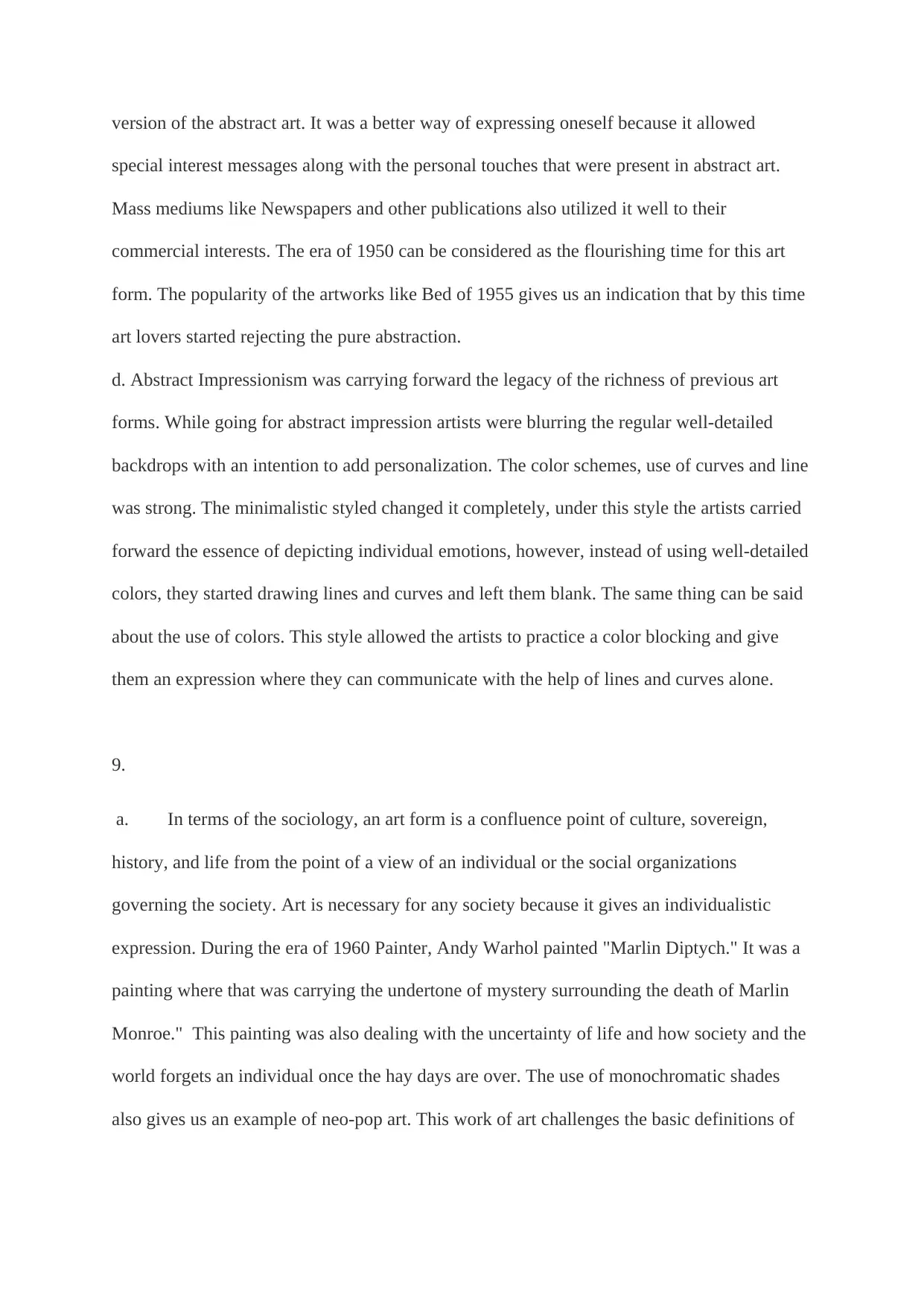
version of the abstract art. It was a better way of expressing oneself because it allowed
special interest messages along with the personal touches that were present in abstract art.
Mass mediums like Newspapers and other publications also utilized it well to their
commercial interests. The era of 1950 can be considered as the flourishing time for this art
form. The popularity of the artworks like Bed of 1955 gives us an indication that by this time
art lovers started rejecting the pure abstraction.
d. Abstract Impressionism was carrying forward the legacy of the richness of previous art
forms. While going for abstract impression artists were blurring the regular well-detailed
backdrops with an intention to add personalization. The color schemes, use of curves and line
was strong. The minimalistic styled changed it completely, under this style the artists carried
forward the essence of depicting individual emotions, however, instead of using well-detailed
colors, they started drawing lines and curves and left them blank. The same thing can be said
about the use of colors. This style allowed the artists to practice a color blocking and give
them an expression where they can communicate with the help of lines and curves alone.
9.
a. In terms of the sociology, an art form is a confluence point of culture, sovereign,
history, and life from the point of a view of an individual or the social organizations
governing the society. Art is necessary for any society because it gives an individualistic
expression. During the era of 1960 Painter, Andy Warhol painted "Marlin Diptych." It was a
painting where that was carrying the undertone of mystery surrounding the death of Marlin
Monroe." This painting was also dealing with the uncertainty of life and how society and the
world forgets an individual once the hay days are over. The use of monochromatic shades
also gives us an example of neo-pop art. This work of art challenges the basic definitions of
special interest messages along with the personal touches that were present in abstract art.
Mass mediums like Newspapers and other publications also utilized it well to their
commercial interests. The era of 1950 can be considered as the flourishing time for this art
form. The popularity of the artworks like Bed of 1955 gives us an indication that by this time
art lovers started rejecting the pure abstraction.
d. Abstract Impressionism was carrying forward the legacy of the richness of previous art
forms. While going for abstract impression artists were blurring the regular well-detailed
backdrops with an intention to add personalization. The color schemes, use of curves and line
was strong. The minimalistic styled changed it completely, under this style the artists carried
forward the essence of depicting individual emotions, however, instead of using well-detailed
colors, they started drawing lines and curves and left them blank. The same thing can be said
about the use of colors. This style allowed the artists to practice a color blocking and give
them an expression where they can communicate with the help of lines and curves alone.
9.
a. In terms of the sociology, an art form is a confluence point of culture, sovereign,
history, and life from the point of a view of an individual or the social organizations
governing the society. Art is necessary for any society because it gives an individualistic
expression. During the era of 1960 Painter, Andy Warhol painted "Marlin Diptych." It was a
painting where that was carrying the undertone of mystery surrounding the death of Marlin
Monroe." This painting was also dealing with the uncertainty of life and how society and the
world forgets an individual once the hay days are over. The use of monochromatic shades
also gives us an example of neo-pop art. This work of art challenges the basic definitions of
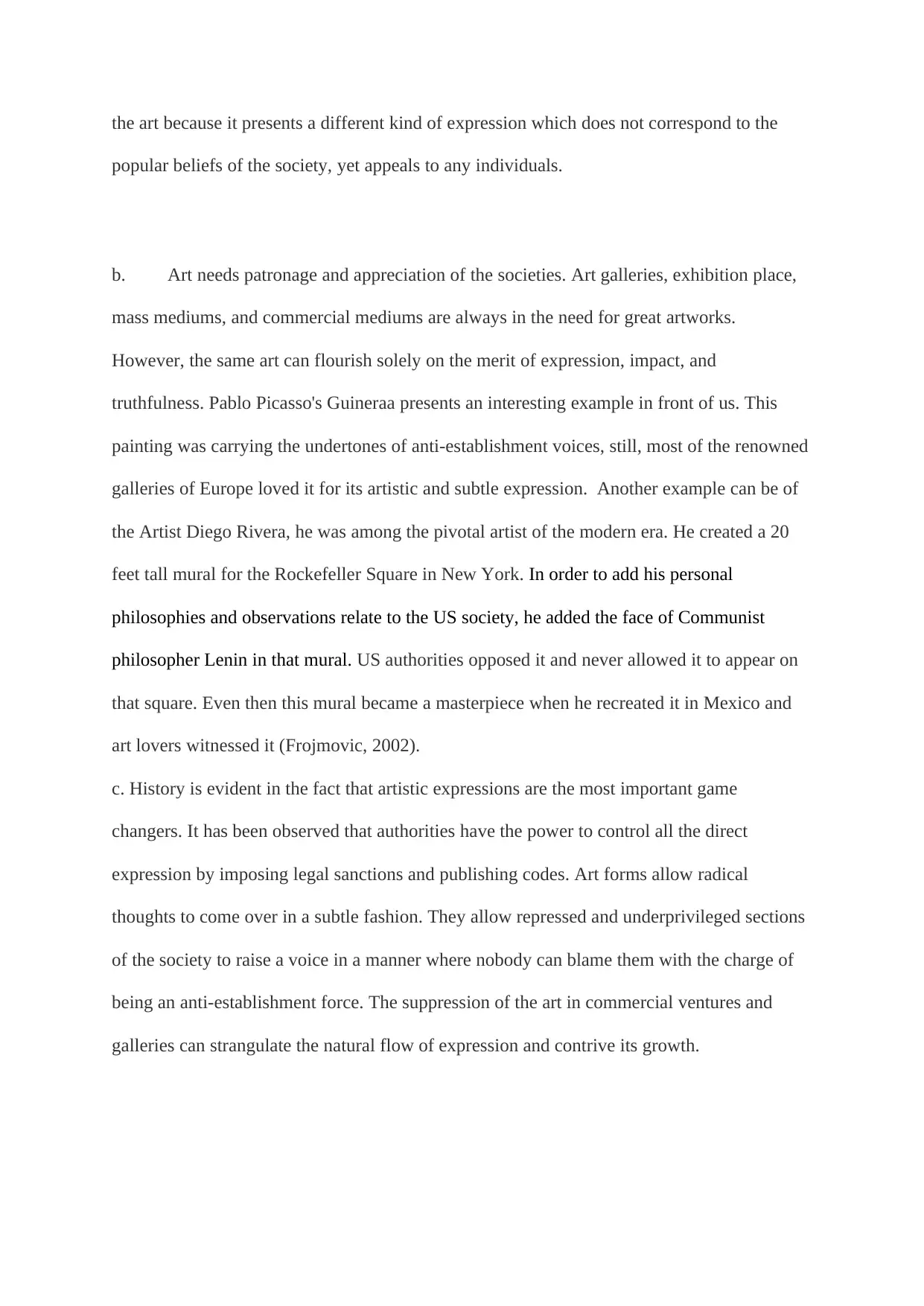
the art because it presents a different kind of expression which does not correspond to the
popular beliefs of the society, yet appeals to any individuals.
b. Art needs patronage and appreciation of the societies. Art galleries, exhibition place,
mass mediums, and commercial mediums are always in the need for great artworks.
However, the same art can flourish solely on the merit of expression, impact, and
truthfulness. Pablo Picasso's Guineraa presents an interesting example in front of us. This
painting was carrying the undertones of anti-establishment voices, still, most of the renowned
galleries of Europe loved it for its artistic and subtle expression. Another example can be of
the Artist Diego Rivera, he was among the pivotal artist of the modern era. He created a 20
feet tall mural for the Rockefeller Square in New York. In order to add his personal
philosophies and observations relate to the US society, he added the face of Communist
philosopher Lenin in that mural. US authorities opposed it and never allowed it to appear on
that square. Even then this mural became a masterpiece when he recreated it in Mexico and
art lovers witnessed it (Frojmovic, 2002).
c. History is evident in the fact that artistic expressions are the most important game
changers. It has been observed that authorities have the power to control all the direct
expression by imposing legal sanctions and publishing codes. Art forms allow radical
thoughts to come over in a subtle fashion. They allow repressed and underprivileged sections
of the society to raise a voice in a manner where nobody can blame them with the charge of
being an anti-establishment force. The suppression of the art in commercial ventures and
galleries can strangulate the natural flow of expression and contrive its growth.
popular beliefs of the society, yet appeals to any individuals.
b. Art needs patronage and appreciation of the societies. Art galleries, exhibition place,
mass mediums, and commercial mediums are always in the need for great artworks.
However, the same art can flourish solely on the merit of expression, impact, and
truthfulness. Pablo Picasso's Guineraa presents an interesting example in front of us. This
painting was carrying the undertones of anti-establishment voices, still, most of the renowned
galleries of Europe loved it for its artistic and subtle expression. Another example can be of
the Artist Diego Rivera, he was among the pivotal artist of the modern era. He created a 20
feet tall mural for the Rockefeller Square in New York. In order to add his personal
philosophies and observations relate to the US society, he added the face of Communist
philosopher Lenin in that mural. US authorities opposed it and never allowed it to appear on
that square. Even then this mural became a masterpiece when he recreated it in Mexico and
art lovers witnessed it (Frojmovic, 2002).
c. History is evident in the fact that artistic expressions are the most important game
changers. It has been observed that authorities have the power to control all the direct
expression by imposing legal sanctions and publishing codes. Art forms allow radical
thoughts to come over in a subtle fashion. They allow repressed and underprivileged sections
of the society to raise a voice in a manner where nobody can blame them with the charge of
being an anti-establishment force. The suppression of the art in commercial ventures and
galleries can strangulate the natural flow of expression and contrive its growth.
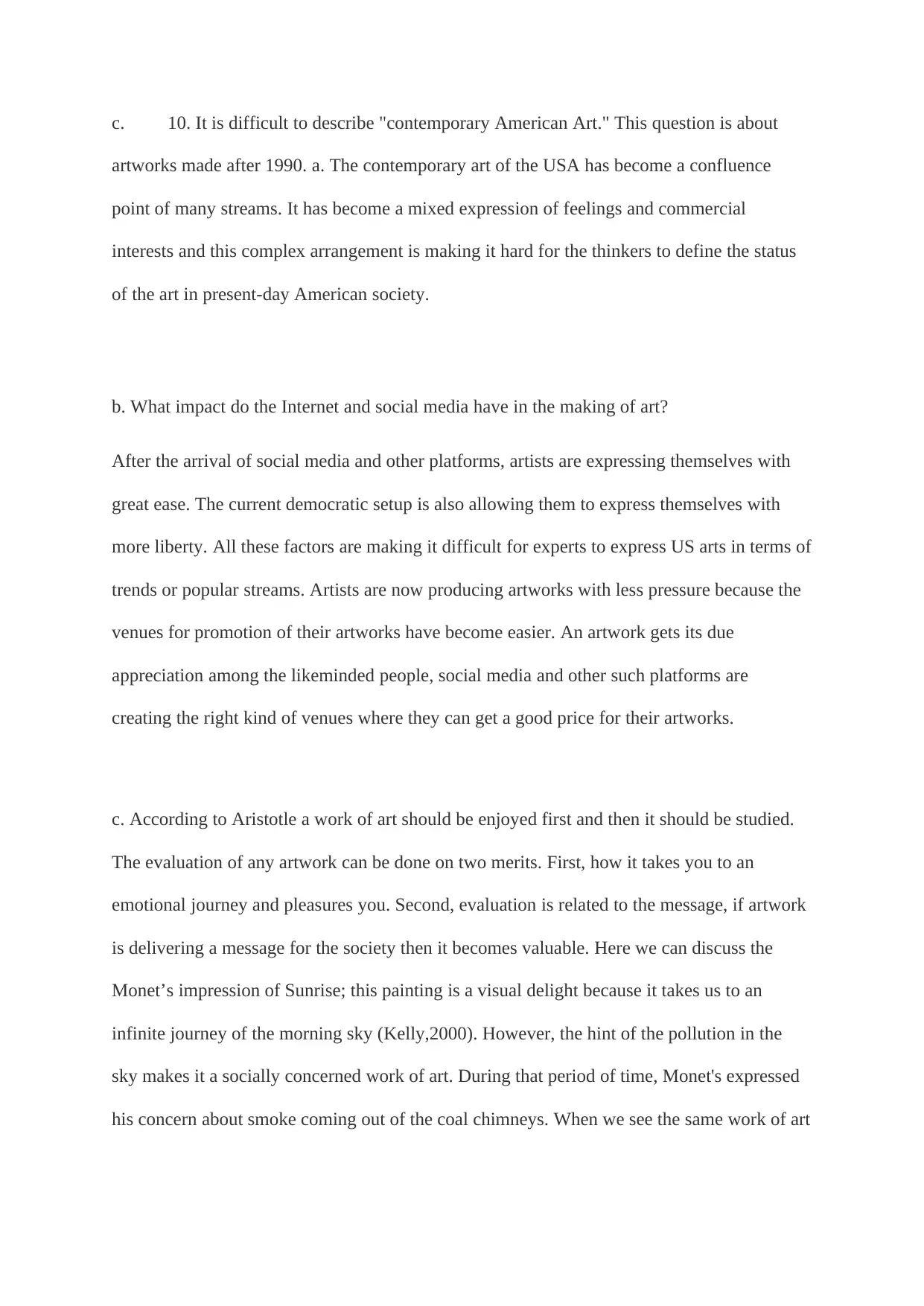
c. 10. It is difficult to describe "contemporary American Art." This question is about
artworks made after 1990. a. The contemporary art of the USA has become a confluence
point of many streams. It has become a mixed expression of feelings and commercial
interests and this complex arrangement is making it hard for the thinkers to define the status
of the art in present-day American society.
b. What impact do the Internet and social media have in the making of art?
After the arrival of social media and other platforms, artists are expressing themselves with
great ease. The current democratic setup is also allowing them to express themselves with
more liberty. All these factors are making it difficult for experts to express US arts in terms of
trends or popular streams. Artists are now producing artworks with less pressure because the
venues for promotion of their artworks have become easier. An artwork gets its due
appreciation among the likeminded people, social media and other such platforms are
creating the right kind of venues where they can get a good price for their artworks.
c. According to Aristotle a work of art should be enjoyed first and then it should be studied.
The evaluation of any artwork can be done on two merits. First, how it takes you to an
emotional journey and pleasures you. Second, evaluation is related to the message, if artwork
is delivering a message for the society then it becomes valuable. Here we can discuss the
Monet’s impression of Sunrise; this painting is a visual delight because it takes us to an
infinite journey of the morning sky (Kelly,2000). However, the hint of the pollution in the
sky makes it a socially concerned work of art. During that period of time, Monet's expressed
his concern about smoke coming out of the coal chimneys. When we see the same work of art
artworks made after 1990. a. The contemporary art of the USA has become a confluence
point of many streams. It has become a mixed expression of feelings and commercial
interests and this complex arrangement is making it hard for the thinkers to define the status
of the art in present-day American society.
b. What impact do the Internet and social media have in the making of art?
After the arrival of social media and other platforms, artists are expressing themselves with
great ease. The current democratic setup is also allowing them to express themselves with
more liberty. All these factors are making it difficult for experts to express US arts in terms of
trends or popular streams. Artists are now producing artworks with less pressure because the
venues for promotion of their artworks have become easier. An artwork gets its due
appreciation among the likeminded people, social media and other such platforms are
creating the right kind of venues where they can get a good price for their artworks.
c. According to Aristotle a work of art should be enjoyed first and then it should be studied.
The evaluation of any artwork can be done on two merits. First, how it takes you to an
emotional journey and pleasures you. Second, evaluation is related to the message, if artwork
is delivering a message for the society then it becomes valuable. Here we can discuss the
Monet’s impression of Sunrise; this painting is a visual delight because it takes us to an
infinite journey of the morning sky (Kelly,2000). However, the hint of the pollution in the
sky makes it a socially concerned work of art. During that period of time, Monet's expressed
his concern about smoke coming out of the coal chimneys. When we see the same work of art
Secure Best Marks with AI Grader
Need help grading? Try our AI Grader for instant feedback on your assignments.
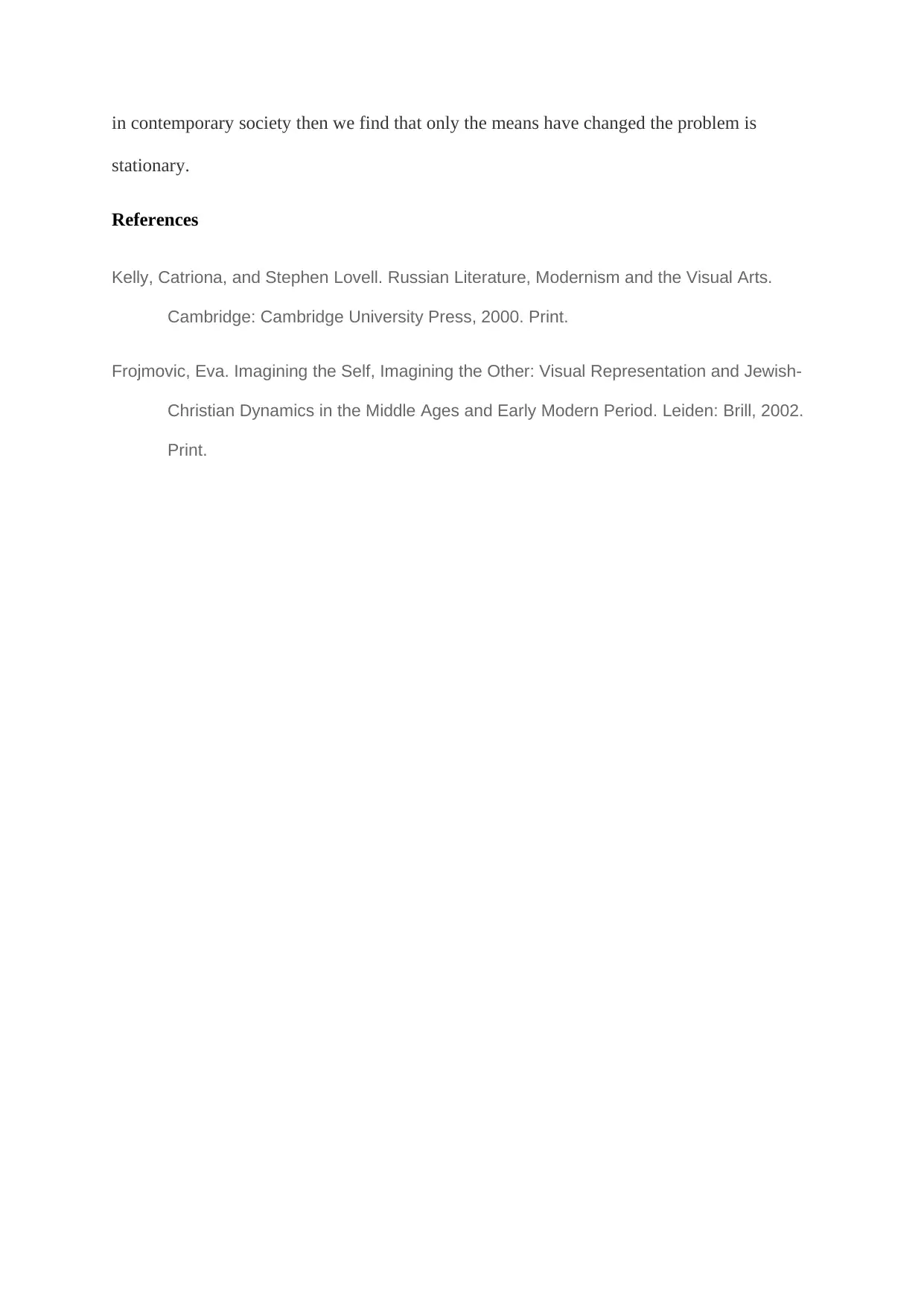
in contemporary society then we find that only the means have changed the problem is
stationary.
References
Kelly, Catriona, and Stephen Lovell. Russian Literature, Modernism and the Visual Arts.
Cambridge: Cambridge University Press, 2000. Print.
Frojmovic, Eva. Imagining the Self, Imagining the Other: Visual Representation and Jewish-
Christian Dynamics in the Middle Ages and Early Modern Period. Leiden: Brill, 2002.
Print.
stationary.
References
Kelly, Catriona, and Stephen Lovell. Russian Literature, Modernism and the Visual Arts.
Cambridge: Cambridge University Press, 2000. Print.
Frojmovic, Eva. Imagining the Self, Imagining the Other: Visual Representation and Jewish-
Christian Dynamics in the Middle Ages and Early Modern Period. Leiden: Brill, 2002.
Print.
1 out of 11
Related Documents
Your All-in-One AI-Powered Toolkit for Academic Success.
+13062052269
info@desklib.com
Available 24*7 on WhatsApp / Email
![[object Object]](/_next/static/media/star-bottom.7253800d.svg)
Unlock your academic potential
© 2024 | Zucol Services PVT LTD | All rights reserved.




